
[ Overview |
lucernhammer MT |
Serenity |
Onyx |
Galaxy |
Orion |
Lyra |
Emerald |
Sapphire ]
[ lucernhammer RCS Server |
Benchmark Data |
FAQ |
Ordering Information ]

[ Overview |
lucernhammer MT |
Serenity |
Onyx |
Galaxy |
Orion |
Lyra |
Emerald |
Sapphire ]
[ lucernhammer RCS Server |
Benchmark Data |
FAQ |
Ordering Information ]
UT Austin Almond Benchmarks
On this page are presented simulated RCS for the conducting, dielectric and composite almond targets from the Austin Benchmark Suites for Computational Electromagnetics, a publicly available benchmark suite for RCS simulations. The suite is available on github via the following link:
http://github.com/UTAustinCEMGroup/AustinCEMBenchmarks.
The construction and measurement of these almonds was discussed in detail in the following papers:
T. Kelley, D. A. Chamulak, C. C. Courtney, and A. E. Yilmaz, "Rye canyon radar cross-section measurements of benchmark almond targets," IEEE Antennas Propagat. Mag., vol. 52, pp. 120–135, February 2020.
and
J. T. Kelley, D. A. Chamulak, C. C. Courtney, and A. E. Yilmaz, "Measurements of non-metallic targets for the Austin RCS benchmark suite," in Proc. Ant. Meas. Tech. Assoc. (AMTA) Symp, 2019.
Some of the simulated data below was also presented previously in Chapter 9 of our book The Method of Moments in Electromagnetics, Third Edition.
The almond is an excellent test target for computational electromagnetic codes, as its unique shape gives rise to many different scattering effects, including specular scattering, traveling and creeping waves, and tip diffraction.
The almonds considered in the UT Austin benchmark suite have the same exterior dimensions as the NASA external dimensions as the NASA Almond from the EMCC benchmark suite. However, they have different material properties and configurations, as described below.

|

|
| NASA Almond Profile in xy plane | UT Austin Almond Profile with "front" and "rear" halves |
The UT Austin almonds were first 3D-printed in resin, to match the exterior dimensions of the NASA almond, and then smoothed by hand. These resin almonds were then further modified to create PEC, dielectric and composite test articles (see the referenced papers for more details on their process).
The solid resin almond comprises the first finished test article. The PEC almond was then obtained by simply coating the solid resin almond with a layer of highly conductive silver paint. The other objects were then obtained by splitting the resin almond at a distance of 5.796 inches from the tip (see above right), and by then performing additional modifications. These are summarized as follows:

|
| Resin Permittivity Values |
The permittivity values of the dielectric resin are summarized in the table above, taken from the benchmark. These were entered as-is into the Serenity material summary file.
Facet model construction is done slightly than it was for the NASA almond. In this case, we have created separate models for the exterior of the front portion, exterior of the rear portion, and the septum between the two, each having a different iCoat (coating ID). These can be combined to create the four test cases described above as inputs to Serenity.
Original Rhinoceros 3D models are provided for each object, however these may contain just the bounding curve, or a portion of the 3d surface, etc. If you want to construct a mesh from these models, additional work may be needed, such as revolution around an axis, as well as exporting into a meshing tool of choice. All meshes below were made using Altair Hypermesh. The original Rhinoceros model used for the NASA Almond in the EMCC benchmark was used here as a starting point, with modifications made that bifurcate the model into its front and rear sections, and septum (see below).
We note that simulated results are also present in the UT Austin benchmark suite for these objects, however the CAD models used as input to those codes were not provided. As a result, there will be differences between those simulated results and those presented here, solely due to differences in the triangular surface models that were used, and not due to any inherent difference between solvers. Thus, that simulated data is not reproduced here.
All calculations below were performed on a Dell Precision T7900 workstation running Ubuntu Linux, with dual twelve-core Intel Xeon CPUs (E5-2690 v3) at 2.6 GHz with 256 GB of RAM, and dual NVIDIA GTX 1080Ti GPUs, each with 12GB of onboard RAM. Serenity utilizes both GPUs.
We first consider the PEC almond, which was fabricated following the same external dimensions as the NASA Almond from the EMCC benchmark suite. The difference in this case is that the UT Austin PEC almond was first 3D-printed in resin, smoothed by hand, and then coated with a thin layer of highly conductive silver paint.
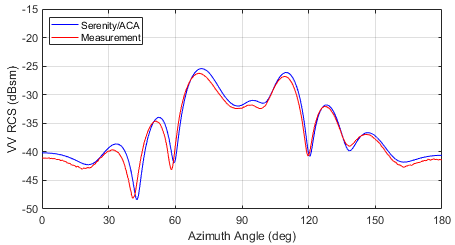
|
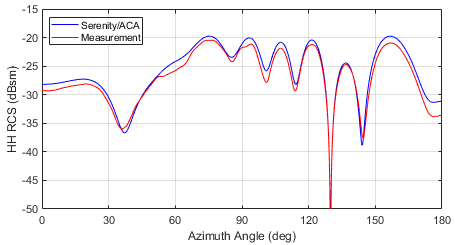
|
| UT Austin PEC Almond VV RCS, 3.5 GHz | UT Austin PEC Almond HH RCS, 3.5 GHz |

|

|
| UT Austin PEC Almond VV RCS, 5.125 GHz | UT Austin PEC Almond HH RCS, 5.125 GHz |
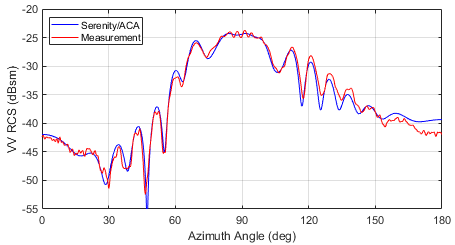
|

|
| UT Austin PEC Almond VV RCS, 7.0 GHz | UT Austin PEC Almond HH RCS, 7.0 GHz |
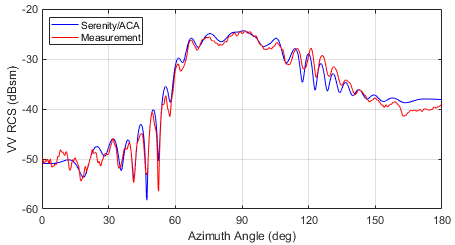
|

|
| UT Austin PEC Almond VV RCS, 10.25 GHz | UT Austin PEC Almond HH RCS, 10.25 GHz |
Compared here is the RCS of the UT Austin PEC almond at 3.5, 5.125, 7.0 and 10.25 GHz.
3.5 GHz Data:

|

|
| UT Austin Solid Resin Almond VV RCS, 2.58 GHz | UT Austin Solid Resin Almond HH RCS, 2.58 GHz |

|

|
| UT Austin Solid Resin Almond VV RCS, 5.125 GHz | UT Austin Solid Resin Almond HH RCS, 5.125 GHz |

|
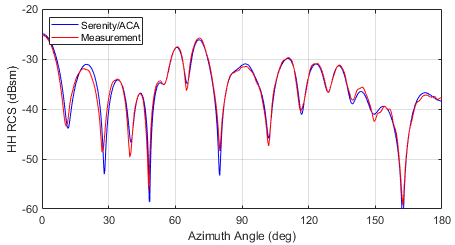
|
| UT Austin Solid Resin Almond VV RCS, 7.0 GHz | UT Austin Solid Resin Almond HH RCS, 7.0 GHz |

|

|
| UT Austin Solid Resin Almond VV RCS, 10.25 GHz | UT Austin Solid Resin Almond HH RCS, 10.25 GHz |
Compared here is the RCS of the UT Austin solid resin almond at 2.58, 5.125, 7.0 and 10.25 GHz.
Materials Files:
2.58 GHz Data:

|

|
| UT Austin Closed-Tail Almond VV RCS, 2.58 GHz | UT Austin Closed-Tail Almond HH RCS, 2.58 GHz |

|

|
| UT Austin Closed-Tail Almond VV RCS, 5.125 GHz | UT Austin Closed-Tail Almond HH RCS, 5.125 GHz |

|
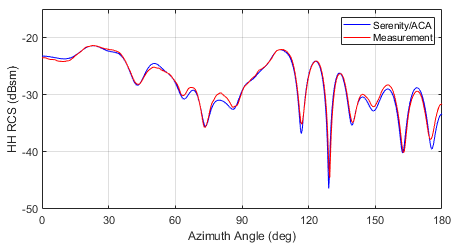
|
| UT Austin Closed-Tail Almond VV RCS, 7.0 GHz | UT Austin Closed-Tail Almond HH RCS, 7.0 GHz |

|

|
| UT Austin Closed-Tail Almond VV RCS, 10.25 GHz | UT Austin Closed-Tail Almond HH RCS, 10.25 GHz |
Compared here is the RCS of the UT Austin closed-tail almond at 2.58, 5.125, 7.0 and 10.25 GHz.
Materials Files:
2.58 GHz Data:

|
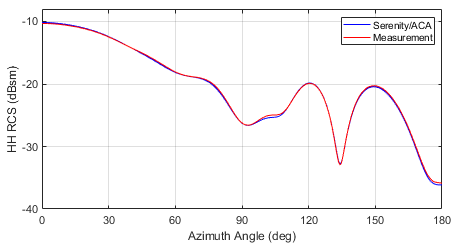
|
| UT Austin Open-Tail Almond VV RCS, 2.58 GHz | UT Austin Open-Tail Almond HH RCS, 2.58 GHz |

|

|
| UT Austin Open-Tail Almond VV RCS, 5.125 GHz | UT Austin Open-Tail Almond HH RCS, 5.125 GHz |
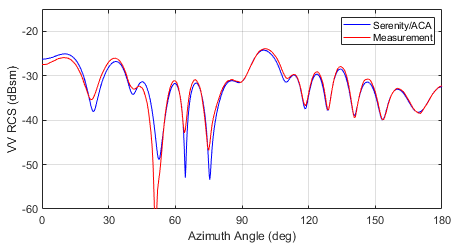
|

|
| UT Austin Open-Tail Almond VV RCS, 7.0 GHz | UT Austin Open-Tail Almond HH RCS, 7.0 GHz |

|

|
| UT Austin Open-Tail Almond VV RCS, 10.25 GHz | UT Austin Open-Tail Almond HH RCS, 10.25 GHz |
Compared here is the RCS of the UT Austin open-tail almond at 2.58, 5.125, 7.0 and 10.25 GHz.
Materials Files:
2.58 GHz Data: